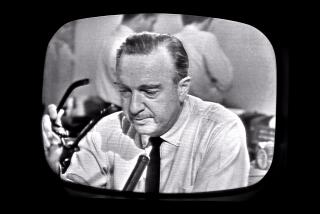Perspective: Are we afraid to watch white people dying?
Are we being selective about the videos that traumatize us?
On Wednesday morning, a man identifying himself as former TV reporter Bryce Williams posted a first-person video of himself shooting two Virginia journalists. The shooting was also broadcast live on television. The victims, a cameraman and a reporter at WDBJ-TV in Roanoke, were killed. The shooter, whom police identified by his given name of Vester Lee Flanagan II, later died of self-inflicted wounds.
Whether or not to show those videos — and how — has become a topic of debate on social media. So, too, have the races of the shooter and the victims. Both victims were white, and the gunman was black. Some Internet commenters have criticized news outlets that did not emphasize the shooter’s race, accusing them of hiding a trend of black violence.
But others ask whether major media outlets hesitated to show the footage because the victims who were dying on camera were white.
Online, some are questioning the conversations that happen in newsrooms before we post, share or edit videos. Are news outlets simply less troubled by the deaths of black people, and thus making the rest of America so?
The question is complicated — both because of the nature of the footage and because, in fact, white deaths have been shown. Last week, for example, the Los Angeles Times published footage of the fatal police shooting of John Berry, who was white (the moments of the shooting itself are not visible in the footage).
The Times’ article on the Virginia shooting includes a screen shot of the gunman’s Facebook page, including a screen shot of footage of the shooting, apparently taken by the gunman himself. The Times also decided to post a clip that stops just before the actual shooting.
Other media outlets have taken a cautious approach to the WDBJ-TV footage. The New York Times links to a YouTube video of the live broadcast during which the shooting occurred but did not embed it on its website. In an emailed statement, the Times explained that it wanted to “give readers the option of viewing it” but did not want to force a “disturbing video on anyone who came to our site.”
The article describes, but does not link to, the gunman’s own footage.
But in the New York Times’ July 30 story on the shooting of a black man named Sam DuBose by a University of Cincinnati police officer, there is an embedded video just below the headline and before the first sentence. This video is also in first person, from the officer’s body camera. As with the WDBJ-TV shooter’s footage, the viewer can see a hand holding the gun. The video plays in its entirety, though DuBose’s head is blurred as the fatal shot is fired.
Dan Abrams, founder of Mediaite and a former MSNBC general manager, tweeted that he had seen the video posted by the shooter but that his site would not run the footage.
But like the New York Times, Mediaite did run footage of DuBose being shot in the face last month.
And as with the New York Times, that footage was integrated into Mediaite’s website — not simply linked to YouTube. The video is embedded with Mediaite’s custom-branded player, including the Mediaite logo in the bottom right corner. The video is grainy but uncensored. Viewers see the incident from start to finish.
Abrams later clarified that Mediaite would “run video leading up to [the Virginia] shooting but not the part that just scarred me for life.”
That has led to this question on social media: Are the deaths of black people not scarring?
Part of the media’s hesitation could be because the Virginia gunman’s video appears to have been uploaded by the shooter himself, so publishing it could be akin to distributing footage of killings by Islamic State. Or perhaps this is a case of emotional proximity. Professional journalists can imagine being attacked in a similar situation. The victims were people like them.
But over the last year, millions of black people have seen people like themselves brutalized, harassed and even killed — on television and online, repeatedly.
It could be argued that those are cases in which the media feel the need to hold police accountable. But those videos are still graphic. We saw Walter Scott collapse when he was shot in April in South Carolina — from a distance, but the video is steady and clear. We saw and heard Eric Garner gasp, “I can’t breathe” as a New York Police Department officer put him in an apparent chokehold. And we saw a first-person view of Sam DuBose’s head exploding when he was shot by the University of Cincinnati police officer.
By comparison, the WDBJ shooting is less graphic. The footage is too shaky to see much. The gunman apparently drops his camera almost immediately after the first few shots are fired. We hear screams but see almost nothing. In the station’s own video, we see even less.
Every time a police killing of a black person begins to circulate on social media, there is a small but vocal population who ask their friends not to share the videos on their timelines. They know the story already, many say — they just can’t bear to watch another one. As a writer on religious website Patheos.com argued, “no one has to watch these videos to be fully informed” about killings.
On Wednesday afternoon, the #WeStandWithWDBJ hashtag went viral, with journalists of all races and backgrounds tweeting messages of condolence to the co-workers of the victims. As with those black people who cannot bear to watch killings of other blacks, the hashtag is a raw, honest, emotional response to seeing violence against someone who looks like them.
A cautious approach is understandable. Violence is traumatic, and it is especially so when you are watching the death of one of your own.
But the question remains: What of the millions of black people who have watched the on-camera deaths of so many of their own?
What of their trauma?
Follow me @dexdigi for more on the intersection of culture and the Internet.
More to Read
Sign up for Essential California
The most important California stories and recommendations in your inbox every morning.
You may occasionally receive promotional content from the Los Angeles Times.











